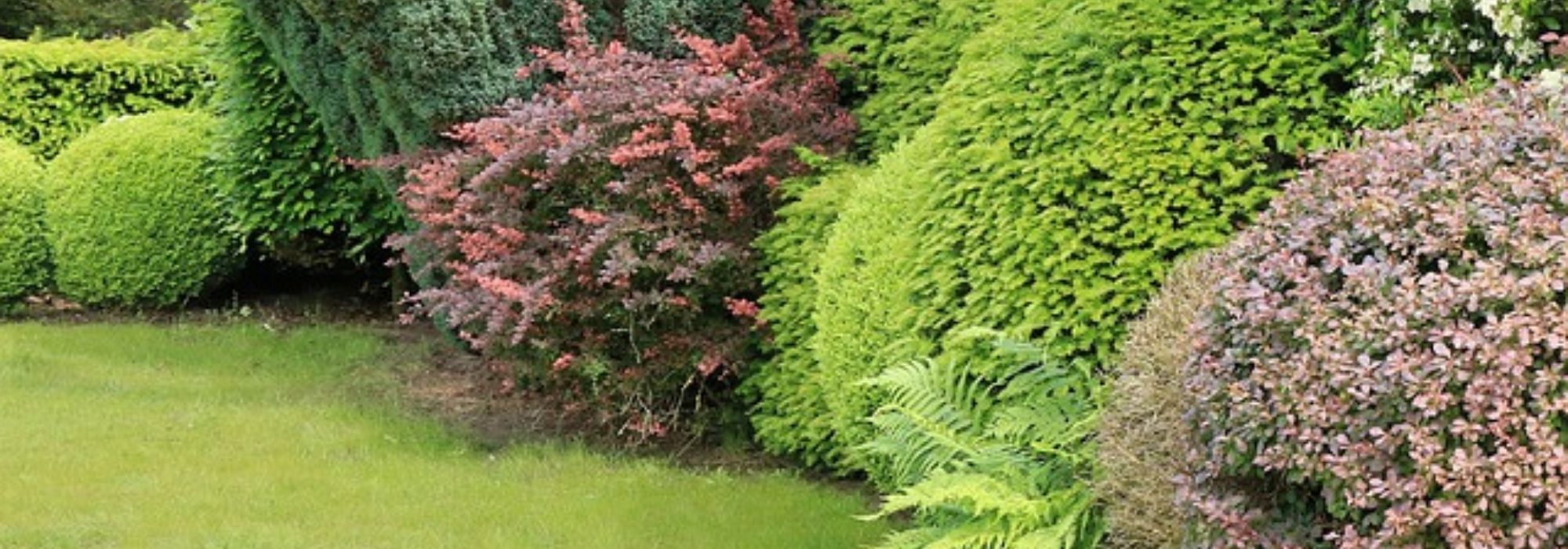
Using evergreen shrubs in the garden
our tips
Contents
Valuable in many ways, shrubs with evergreen foliage are, because of their perennial character, indispensable in gardens. Decorative all year round, they bring to spaces a lovely diversity of shapes, colours and flowering. By the volume they provide even in winter, evergreen foliage plays a major role in a garden’s structure. They are generally quite easy to use. Discover everything you can do with bushes with evergreen foliage and, above all, how to use them to best effect according to garden areas and your needs… from garden to terrace, you’ll soon be unable to do without them!

Evergreen shrubs allow strong lines to be kept in winter: here bay laurel, box and lavender
As key structural elements
When redesigning or creating a garden, evergreen shrubs, like trees, are very useful as structural elements: they act as a true plant backbone by creating a permanent composition of volumes, colours and heights. Whether pruned or left untrimmed, depending on a garden’s more natural or classical style, evergreen foliage will shape forms, especially valuable during winter when deciduous bushes and many perennials are in dormancy.
To create volume
The habit of bushes is of major importance: volume arises not only from year-round foliage, but also from contrast created by different bush silhouettes. By choosing varied habits, you can create dynamic or gentle compositions: spreading, creeping, erect or rounded habits — there is a wide and indispensable choice to bring relief to the garden and create plant strata.
To balance a planting, combine bushes with different habits: columnar or fastigiate (such as cypress or Cupressus sempervirens, and many conifers), rounded or bushy habits (St John’s wort, Abelias, Ceanothus…), and creeping habits (Juniperus, some Ceanothus, ivies, Cotoneasters…)

The verticality of pruned conifers offers a strong contrast with perennial beds
To create separations or partition
Evergreen bushes are very useful to create sub-spaces in a large garden, or conversely to produce surprise effects in a small garden. They allow partitioning and demarcation of areas to be reserved for specific uses, for example: a vegetable patch, a house entrance, a play area, a composting zone, etc. For this ‘soft’ separation within the garden, use bush heights between 1 m and 2.5 m.
These medium-height bushes can also serve as screens or windbreaks (see below).
Evergreen shrubby honeysuckles, Euonymus (spindle), St John’s wort ‘Hidcote’, Loropetalum, Myrtles, Drimys, Cotoneasters… the choice is extensive!
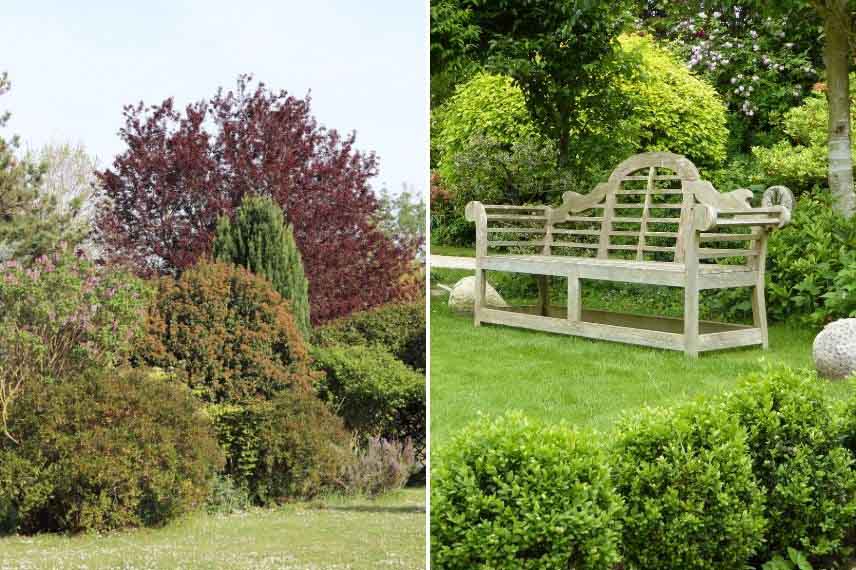
Left, a partition between two gardens using Abelias and Viburnum tinus; right, a relaxing corner defined by dwarf Euonymus and some Pittosporums.
To mark a path or a low wall
Evergreen bushes also structure paths and low walls, which they highlight with their foliage. Well chosen in harmony with materials used for paths and small structures, they provide a strong graphic effect and should therefore be selected with care. Lavender and limestone, for example, make a beautiful pairing, just as pastel tones blend delicately with slate, or blue-flowered plants complement brick.
To create topiary and Niwaki
The famous Niwaki pruning (or cloud pruning) and the creation of topiary can only be performed on evergreen bushes: these geometric or Japonising forms are true sculpted plant works! They bring a great deal of structure to a garden when placed in strategic locations, as focal points, in alignments or as mass effects. They are, however, best suited to classical, contemporary or zen garden styles and to gardeners experienced in this delicate technique. Box and yew are the best subjects, but privet, bay laurel (Laurus nobilis) and Ilex crenata (Japanese holly) also lend themselves magnificently.

An almost perfect geometry for these box topiaries
Read also
Evergreen tree and shrub: what are they?As hedges
For free-form hedges
A large number of evergreen bushes have a natural loose habit, requiring little maintenance. Species over 2 m are well suited to establishing free-form boundary hedges, country-style, in large gardens.
Free-form hedges lend themselves to creation of a multi-species (mixed) hedge: combine several different species (four or five, repeated) with differing foliage (green, variegated, golden, bluish…), which creates a pretty natural look and contributes to garden biodiversity.
Among the many evergreen bushes suitable for free-form hedges, Eleagnus ebbingei (chalef), besides acting as a windbreak and resisting sea spray, displays beautiful silvery or variegated highlights. Classic, sometimes overused Photinia has the merit of producing particularly attractive red foliage in spring; used sparingly within a free-form hedge it becomes interesting. Insert some spiny, flowering bushes to gain an additional security aspect and often spring flowers (Osmanthus, bay (Laurus nobilis), or tall varieties of Ceanothus (Ceanothus Edinburgh). In mild climates, also dare to include less commonly used bushes for this purpose such as Grevillea! Brooms also suit a very natural atmosphere within a free-form hedge.
For use of evergreen bushes in free-form hedges, avoid those whose growth can be anarchic, such as pyracantha, or insert them sparingly into your hedge.
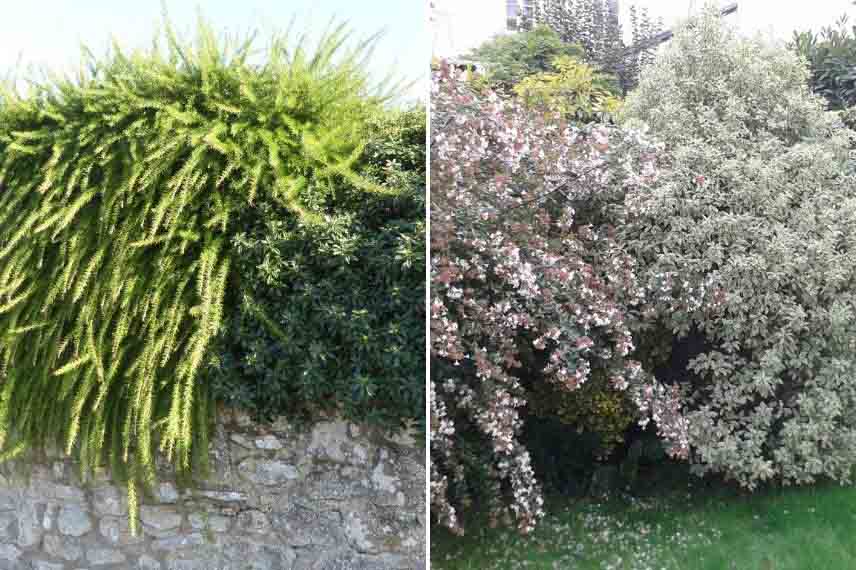
Two free-form hedges a little less ‘conventional’: left Grevillea and Berberis, right Abelia and Pittosporum -photo: Gwenaëlle David Authier
For clipped hedges
Pruning is very well suited to evergreen bushes with small leathery leaves, which tolerate repeated cuts two to three times a year. For this use, shape and colour of foliage will be favoured, as well as compact character of foliage to obtain a perfect screen, avoiding flowering bushes whose flowering would be compromised.
To create a separating hedge between house and street, or neighbour’s garden, you can opt for a single-species hedge, that is made up of the same species for a uniform visual effect and a classic style.
Thuja hedges from the 1970s, once widely used, have suffered in recent years from attacks by several parasitic pests (buprestid beetles and Phytophthora). Instead, choose bushes that are not very susceptible to pests, of medium height, to achieve a decidedly classic effect in a French-style garden, or a very elegant contemporary touch.
Finally favour bushes whose growth is slow (Eleagnus, Euonymus…) or those particularly suited to pruning (Ligustrum or privet, Taxus baccata, pyracantha…). Conifers remain reliable choices for a fine clipped hedge, such as Lawson cypress or Chamaecyparis lawsonia Elwoodi.

Privet hedge clipped to perfection
Discover other Evergreen shrubs
View all →Available in 0 sizes
Available in 1 sizes
Available in 1 sizes
Available in 1 sizes
Available in 1 sizes
Available in 1 sizes
Available in 2 sizes
Available in 1 sizes
Available in 1 sizes
Available in 1 sizes
Shrubs for windbreaks and privacy screening
Evergreen foliage has the great quality of being able to act as a privacy screen for a house, a terrace or an area of the garden that you want to hide (a service room, a damaged wall…)
The occluding character of their foliage creates natural privacy screens, but also windbreaks when placed on an exposed axis or by the sea. Bushes will be chosen at different heights depending on whether a medium or tall hedge is required to conceal the view.
Among bushes well suited to creating windbreaks: Olearia, Elaeagnus, and Prunus lusitanica (Portuguese laurel)
Bamboos are a fast, exotic option when you want to block a view. Take care, however, to choose cespitose specimens (i.e. non-running, such as Fargesias), and to install a rootstock barrier as a preventive measure.
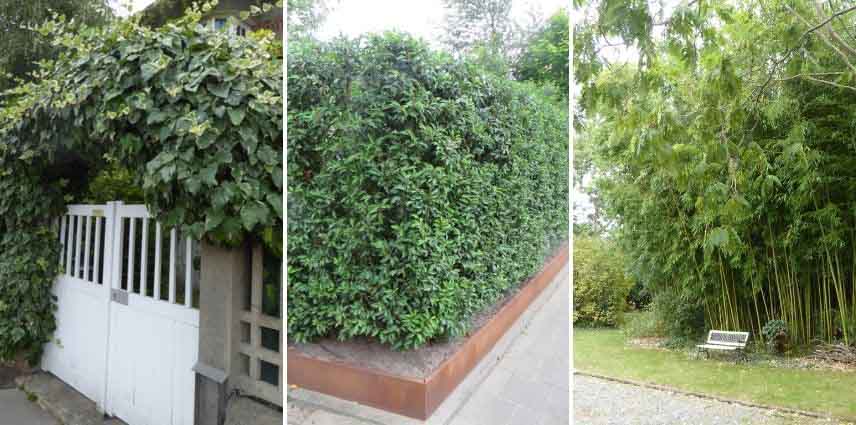
An ivy climbing an archway perfectly hiding a house entrance, a Prunus lusitanica trained into a dense hedge, and on the right bamboos providing a quick, effective privacy screen.
In flower beds
Evergreen bushes add volume and structure to a border. The arrangement is important: they can be placed at the back of a border to bring height and visual dynamism to a bed of perennials. Choose a harmonious plant palette: exotic leaves such as Fatsia japonica fit well in an exotic-inspired border, while an Arbutus unedo will keep good company with another Mediterranean-inspired bush such as pomegranate.
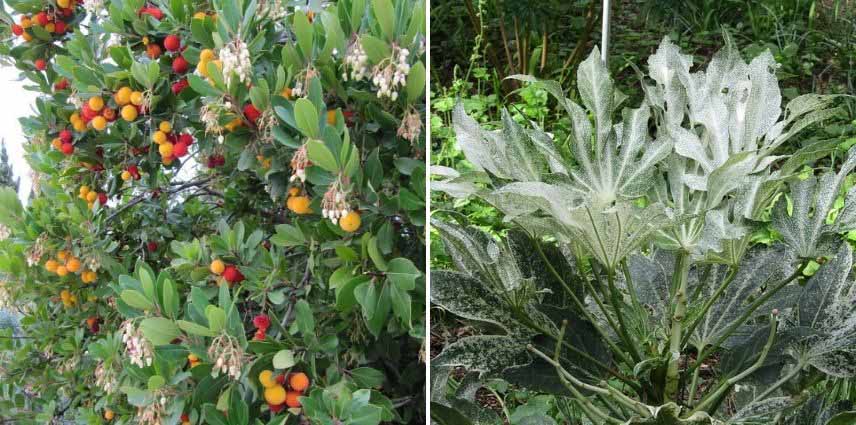
Arbutus unedo (left) and Fatsia japonica (right)
It is also possible to create borders by grouping small bushes to form graphic or contemporary beds. You can arrange small groves of similar varieties to shape mass effects (Pittosporum tobira, Pittosporum ‘Tom Thumb’ and tenuifolium) or play the contrast between leaf textures as shown here with Phormiums and dwarf Hebes.

Phormiums accompany a handsome border of dwarf Hebes
They can also be planted more traditionally within perennials that will accompany them, mixing evergreen and deciduous to bring interest to large bare beds for many months.
Architectural bushes or those with an original habit, even in coppice shoots (multi-stemmed), should be planted alone in the centre of a border to showcase them, such as Arbutus unedo, a Ceanothus trained on a stem, or a small dwarf conifer. Evergreen leaves are generally smaller than deciduous ones, so it is sensible to rely on a wide diversity of leaf shapes, colours and flowerings: narrow leaves, round, dentate, bright green colour (Choisya ‘Sundance’), glaucous (Pinus mugo, Yucca), variegated (Aucuba, Euonymus, Osmanthus…), or purple (Berberis), flowering of Escallonia or Choisya, etc.
Finally, evergreen bushes with a creeping or tapetum habit are useful for forming perennial groundcovers: they provide not only an attractive year-round plant cover at the edge of a border or between different areas, but also save you the chore of weeding: Cotoneasters, Juniperus, Ceanothus, small Cistus are ideal. Discover a selection of bushes !
As borders
Creating dense edging around borders, or in a vegetable plot, is easy with many evergreen, low-growing bushes that can be used as mat-forming groundcovers. Requiring little pruning, as they grow slowly, dwarf shrubby veronicas (Hebe ‘Green Globe’) are very practical and have an attractive compact habit.
Imitating boxwood, Ilex crenata, or Euonymus japonicus ‘Microphyllus’ (dwarf euonymus) are perfect for creating borders in a vegetable plot or a traditional garden, and prove ideal for this use in defining beds.
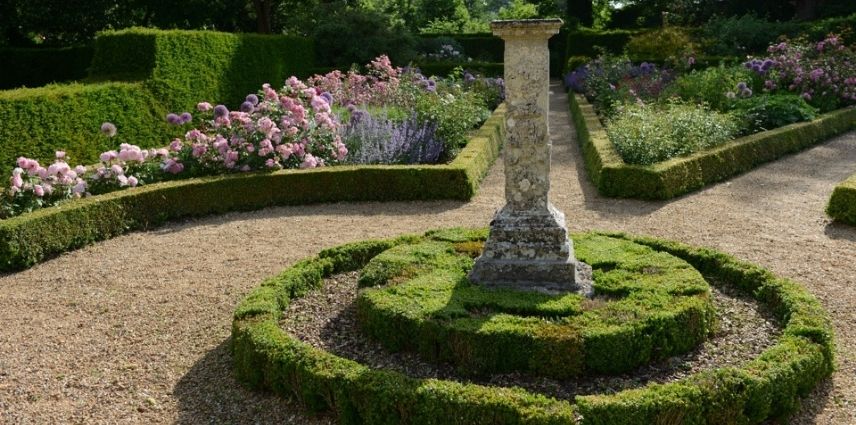
Border of dwarf euonymus in rose garden at Château du Lude (photo: gardens of Château du Lude)
The right balance
Instead of rule of 1/3 evergreens, 2/3 deciduous often prescribed for visual harmony of garden, favour your own composition, taking care always to mix evergreens and deciduous (autumn colours are provided by deciduous leaves). Enjoy choosing bushes you like, and that will above all be suited to your climate, your soil and chosen exposure!
In urban environments, you can allow yourself an all-evergreen scheme on a small terrace to screen off intrusive neighbours. Play with staggering of flowering times and diversity of leaf textures and colours. Same applies to a small town garden where you want to hide an unsightly wall.
A Mediterranean-style rockery is also recommended in 100% evergreens mode, which ensures year-round display and a dry-garden feel. Mix Rosemary, Cistus, and some creeping conifers such as Juniperus squamata ‘Blue Carpet’.
For pools specifically, favour evergreen bushes that avoid chore of leaves collecting in water: choice often turns to essential oils for full sun where pool is generally positioned (Oleanders, rosemary, cistus, lavender, myrtles, even palms or phormium, yuccas for an exotic feel …). Finally, avoid prickly essential oils.
A selection of essential evergreen shrubs
Impossible to list them all here, but here is my selection of evergreen bushes: a few reliable classics and more unusual species, adaptable to many situations, for small or large gardens.
- For informal hedges: Eleagnus ebbingei ‘Limelight’, Ligustrum delavayanum, Japanese euonymus ‘Bravo’
- For clipped hedges: Lawson cypress or Chamaecyparis lawsonia elwoodi
- For purple foliage: the Loropetalum Pipa’s Red,
- In a heather soil bed: majestic rhododendrons in spring, Kalmia latifolia with delightful pink flowers, camellia sasanqua ‘Fukusutsumi’.
- Winter flowering: berberis, Mahonia ‘Sweet caress’, Clematis armandii.
- Spring flowering: Berberis thunbergii, osmanthus, ceanothus with vivid blue flowering, stoechas lavenders with long fragrant flowering, cistus with delightfully crinkled petals.
- Summer flowering: all escallonias, oleanders, hebes, the classic and charming Abelia ‘Edward Goucher’, Hoheria ‘Snow White’
- Fragrant flowering: all lavenders, Mahonia ‘Soft Caress’, Osmanthus fragrans auriantiacus
- Exotic, architectural foliage: Cordylines, Phormiums and Yuccas, Melianthus, Fatsia japonica, Choisya ‘Aztec Pearl’
- For an aromatic garden: grey or purple sages, creeping rosemary
- Climbing plants: the irreplaceable Trachelospermum jasminoides, Hydrangea seemanii attractive even in winter, Lonicera henryi ‘Copper Beauty’, Clematis armandii.
- Small elegant trees: arbutus with Mediterranean charm, loquat for presence of its uniquely corrugated foliage, Hoherias, Magnolia grandiflora ‘Little Gem’.
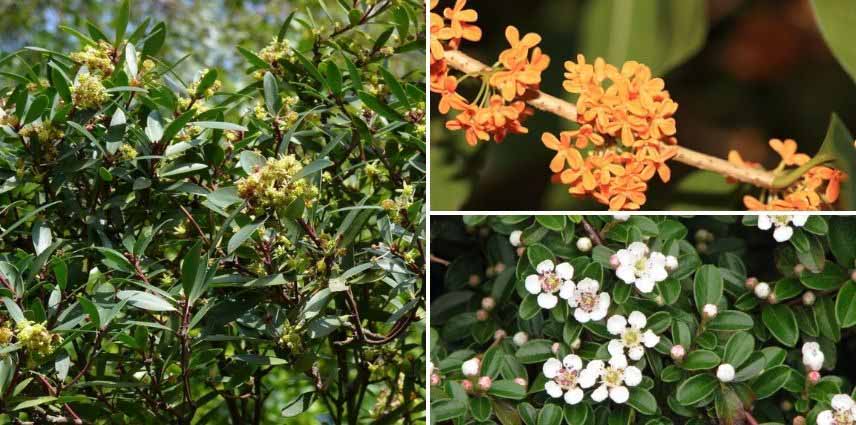
Floral display featuring Drimys aromatica (on left), Osmanthus fragrans aurantiaca (top right), and a groundcover version of Cotoneaster with countless white flowers: Cotoneaster dammeri ‘Evergreen’.
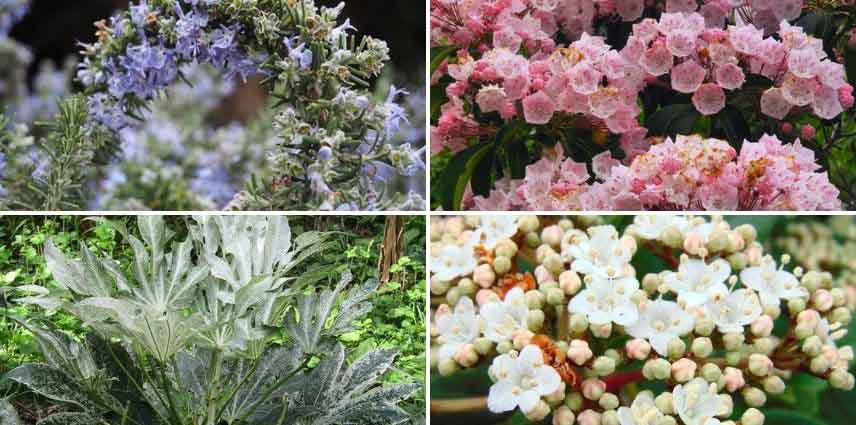 Rosemary, Kalmias, Fatsias, laurels: evergreen bushes display a wide variety of flowering and foliage!
Rosemary, Kalmias, Fatsias, laurels: evergreen bushes display a wide variety of flowering and foliage!
To learn more
Discover our other tips:
- Evergreen trees and bushes: what are they?
- 8 evergreen bushes with rapid growth
- 10 evergreen bushes for coastal gardens
- How to create a defensive hedge?
- Deciduous, evergreen or marcescent foliage: everything you need to know!
- Subscribe!
- Contents
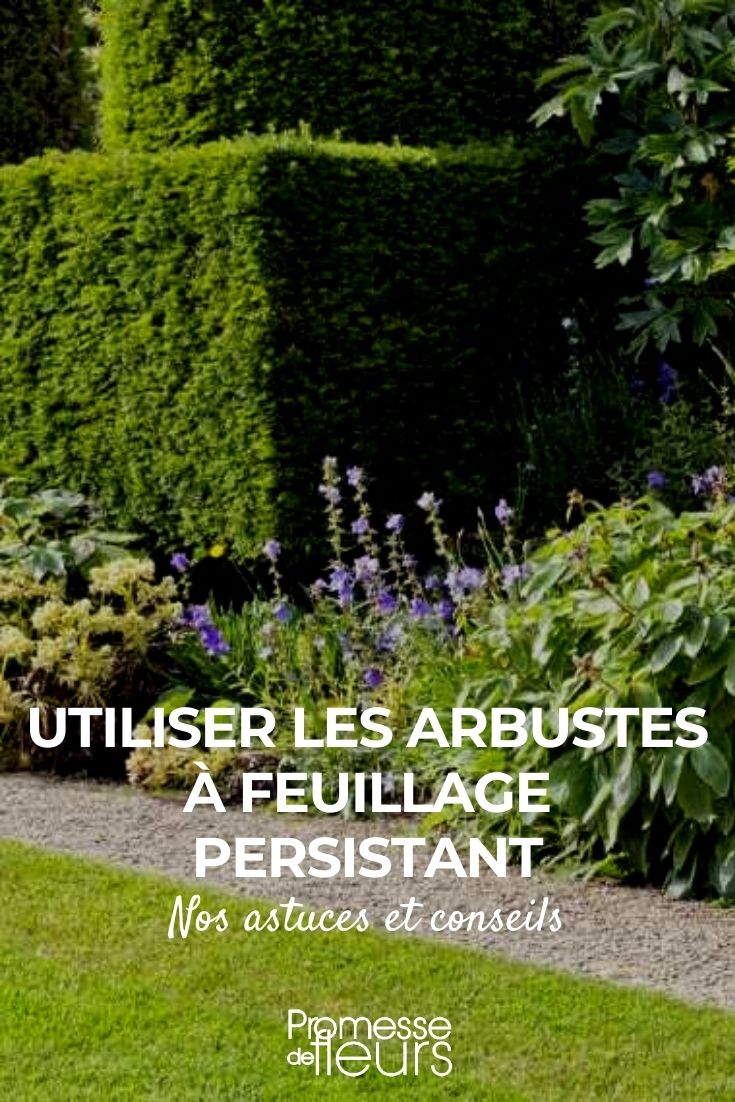
































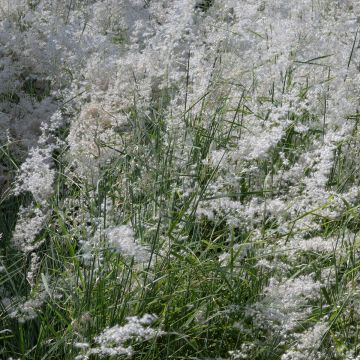
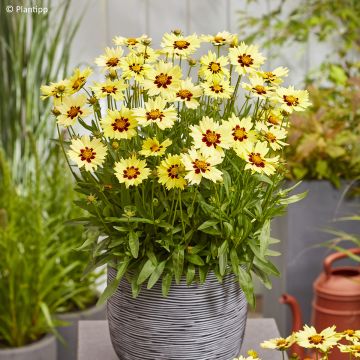
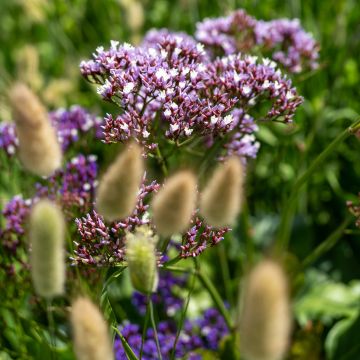

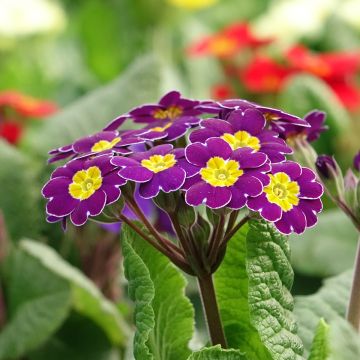
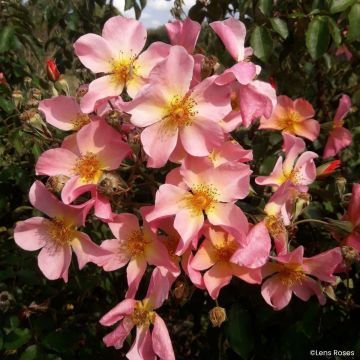
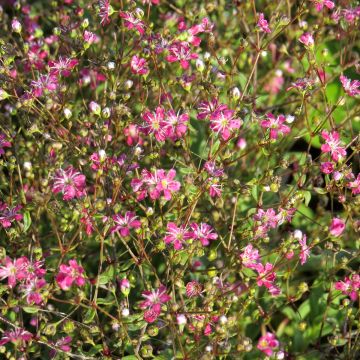
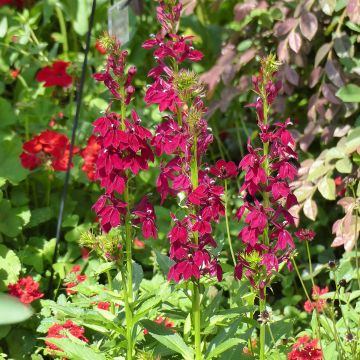
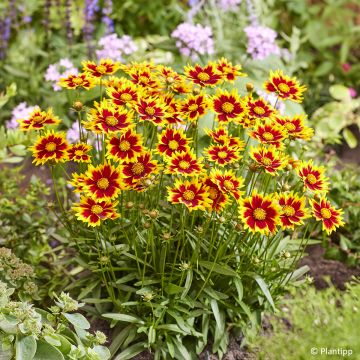
Comments